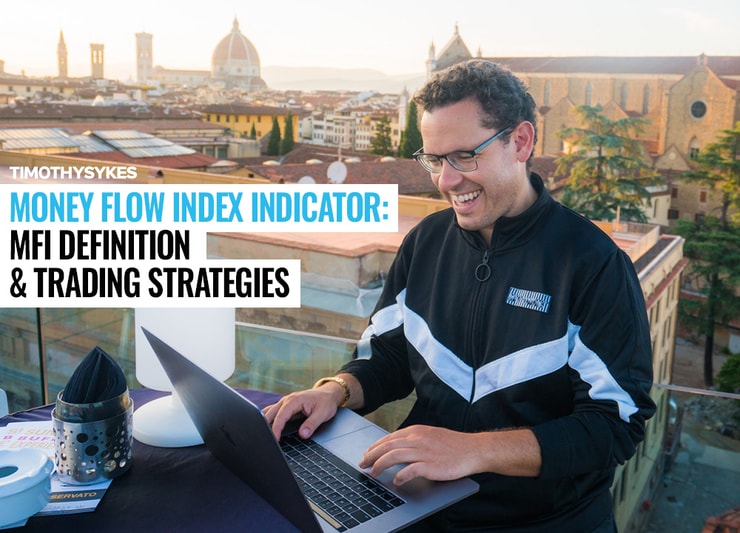*Written by AI, Edited by Humans
Looking to dive into the world of the Money Flow Index (MFI) Indicator? Let’s get real: the MFI isn’t just another tool on the chart; it’s a precise reading of the market’s momentum, a snapshot of money flow into and out of an asset. It’s about understanding the volume and price action, the force that drives markets. This article will help you grasp what the MFI indicator is, and how to capitalize on its insights. We’ll cover everything from basic calculations to intricate trading strategies. Buckle up, this ride’s worth taking.
Table of Contents
- 1 What Is the Money Flow Index (MFI)?
- 2 How To Trade the Signals Delivered by MFI Indicator
- 3 Money Flow Index (MFI) vs. Relative Strength Index (RSI)
- 4 How To Use MFI for Profitable Trading
- 5 Advantages of MFI
- 6 Limitations of the Money Flow Index
- 7 Common Mistakes When Using the MFI Indicator
- 8 Key Takeaways
- 9 Frequently Asked Questions (FAQs)
- 9.1 Is MFI a Good Indicator?
- 9.2 What Is the MFI Indicator Best For?
- 9.3 Is a Higher MFI Better?
- 9.4 How Can MFI Improve My Trading Performance?
- 9.5 Can MFI Be Used in Conjunction with Other Indicators?
- 9.6 What Are the Key Components of the Money Flow Index Indicator?
- 9.7 How Does MFI Indicator Help in Identifying Upside Trades?
- 9.8 What Resources Are Available for Understanding MFI, and Who Created It?
What Is the Money Flow Index (MFI)?
The Money Flow Index (MFI) is a technical oscillator that reflects the intensity of money flow into and out of a security. Think of it as a thermometer for the market’s money pressure. By analyzing both price and volume, it gives traders a snapshot of buying and selling pressure. Simply put, it’s a tool to gauge overbought and oversold levels, giving a clue about potential reversals in trends.
How to Calculate MFI
Calculating MFI isn’t rocket science, but it requires an understanding of a few key components. First, you’ll need to calculate the Typical Price, which is the average of the high, low, and close prices for a given day. Then, multiply this by the volume to get the Money Flow. Finally, divide the Positive Money Flow by the Negative Money Flow and apply it into the formula to get the MFI. Following these steps will give you a line on your chart that oscillates between 0 and 100, indicating the money flow direction.
Or you could just use a great trading platform like StocksToTrade.
When it comes to technical analysis, StocksToTrade is first on my list. It’s a powerful trading platform that integrates with most major brokers. I helped to design it, which means it has all the trading indicators, news sources, and stock screening capabilities that traders like me look for in a platform.
Grab your 14-day StocksToTrade trial today — it’s only $7!
How To Trade the Signals Delivered by MFI Indicator
You’ve got the MFI on your chart. Now what? Trading with MFI involves understanding the signals it sends your way. From overbought and oversold conditions to trend pullbacks, there’s a range of insights to tap into.
The Volume Weighted Average Price (VWAP) is another essential tool that can complement the Money Flow Index (MFI) in your trading strategy. It calculates the average price based on both volume and price, providing a more accurate reflection of the market’s true value. By combining VWAP with MFI, traders can gain deeper insights into market trends and make more informed decisions. Whether you’re looking to identify potential reversals or simply want to understand the market’s direction, the VWAP can be a valuable addition to your toolkit. Learn more about how to integrate the VWAP indicator into your trading strategy.
Overbought and Oversold Conditions
The MFI indicator operates within a range of 0 to 100. Levels above 80 might signal an overbought condition, while levels below 20 may indicate oversold. This information is vital for traders eyeing potential reversals. It’s like a compass pointing you to the trends that might soon change direction.
More Breaking News
- TeraWulf Shares Drop: Time to Cut Losses?
- Is Thor Industries Stock Poised for Growth?
- Ford Stock Surge: What Lies Ahead?
Trend Pullbacks
Trend pullbacks can be your friend when trading with MFI. When you spot divergence between the MFI and price action, that’s a signal of a potential pullback. These divergences occur when the MFI moves in the opposite direction to the price, hinting at a weakening trend.
Divergences
Speaking of divergences, they’re a strong hand you can play in trading. When the MFI indicator shows a high while the price marks a low, or vice versa, you’re looking at a divergence. This could signal a potential reversal. By identifying divergences, you tap into the underlying momentum shifts before they happen.
Money Flow Index (MFI) vs. Relative Strength Index (RSI)
MFI and RSI might seem like twins, but they have distinct differences. While both indicators measure momentum and identify overbought and oversold levels, MFI adds volume into the mix. RSI sticks to price data. Think of MFI as RSI with an extra layer of information, giving you insights into money flow, not just price action.
How To Use MFI for Profitable Trading
Want to make money using MFI? You need a strategy that aligns with market conditions and your trading style. Some traders use MFI in conjunction with moving averages and MACD to pinpoint precise entry and exit points. But remember, profitable trading with MFI is not just about the entry; it’s about setting the right stop-loss and understanding market trends to safeguard your investment.
Advantages of MFI
The Money Flow Index brings a lot to the table. Its ability to factor in volume alongside price sets it apart. By providing an in-depth analysis of buying and selling pressure, MFI allows you to catch reversals early. It’s a tool that can be fine-tuned to various timeframes, from day trading to long-term analysis.
While the Money Flow Index (MFI) offers a robust view of market momentum, understanding volatility is equally crucial for a comprehensive trading strategy. Volatility indicators measure the rate of price changes and provide insights into the market’s stability or instability. By incorporating volatility indicators with MFI, traders can better assess the risks and potential rewards of different market conditions. This combination allows for a more nuanced approach to trading, helping to identify optimal entry and exit points. If you’re interested in enhancing your trading strategy with insights into market volatility, discover more about volatility indicators and how they can benefit your trading approach.
Limitations of the Money Flow Index
No indicator is perfect, and the MFI has its downsides. It might generate false signals in a strongly trending market, and it might be less effective in thinly traded stocks. Like all technical tools, the MFI should never be used in isolation. It’s part of a toolkit, not the entire strategy.
Common Mistakes When Using the MFI Indicator
Jumping in without understanding how MFI works? Big mistake. Using MFI without considering the overall market context? Another pitfall. Common mistakes include ignoring fundamental analysis or relying solely on the MFI for trade decisions. The MFI is a supporting actor, not the star of the show.
Key Takeaways
The MFI indicator is more than a line on a chart; it’s a reflection of market sentiment, a reading of the balance between buying and selling pressure. Understanding its nuances and incorporating it into your trading strategy can add a new dimension to your trading. Just remember: MFI is a tool, not a magic wand.
It isn’t a silver bullet for your trading plan — but the MFI indicator is one of the many topics you should learn as part of your trading education!
Trading isn’t rocket science. It’s a skill you build and work on like any other. Trading has changed my life, and I think this way of life should be open to more people…
I’ve built my Trading Challenge to pass on the things I had to learn for myself. It’s the kind of community that I wish I had when I was starting out.
We don’t accept everyone. If you’re up for the challenge — I want to hear from you.
Apply to the Trading Challenge here.
Trading is a battlefield. The more knowledge you have, the better prepared you’ll be.
Do you use the MFI indicator in your trading strategy? Let me know in the comments — I love hearing from my readers!
Frequently Asked Questions (FAQs)
Is MFI a Good Indicator?
Absolutely. The MFI offers a robust view of the market’s underlying momentum. By incorporating volume with price, it provides a more comprehensive analysis than some other oscillators.
What Is the MFI Indicator Best For?
Identifying overbought and oversold conditions, spotting divergences, and reading the underlying market momentum are some of MFI’s strong suits. It’s versatile and can be adapted to different trading strategies.
Is a Higher MFI Better?
Not necessarily. A higher MFI might indicate an overbought condition, signaling a potential reversal. Context matters; it’s about reading the MFI in conjunction with other indicators and market trends.
How Can MFI Improve My Trading Performance?
By providing insights into buying and selling pressure, the MFI can enhance your ability to identify potential reversals and trend pullbacks. It’s another piece of the puzzle to complete your trading picture.
Can MFI Be Used in Conjunction with Other Indicators?
Yes, the MFI often finds itself in good company with indicators like MACD, moving averages, and support and resistance lines. It’s about blending the right tools to create a trading strategy that suits you.
What Are the Key Components of the Money Flow Index Indicator?
The Money Flow Index Indicator (MFI) is primarily based on several key components. These include the money flow ratio, money ratio, the ratio between positive and negative price changes, recorded values, recent highs in price, and a momentum indicator to gauge the market’s trend strength.
How Does MFI Indicator Help in Identifying Upside Trades?
The MFI Indicator is a valuable example of a tool that helps traders identify potential upside trades. By analyzing the same trends at different times, the indicator provides insights into buying pressure, enabling traders to recognize when the market is overbought or oversold, leading to potential profitable trades.
What Resources Are Available for Understanding MFI, and Who Created It?
For those interested in understanding the MFI, various content resources, news articles, and educational funds are available. The number of online platforms providing this information is growing. Gene Quong, a well-known figure in the field, is credited with the development of the Money Flow Index Indicator. Careers in finance and trading may also include working with tools like MFI.






Leave a reply